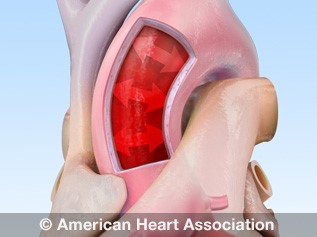What are the Signs and Symptoms of High Blood Pressure?
Quick Facts
- High blood pressure is often called the “silent killer” because there are usually no signs or symptoms.
- It can affect all age groups: children, young adults, adults and older adults.
- High blood pressure needs to be diagnosed in a health care setting.

For most people, high blood pressure has no signs or symptoms. That is why it’s often called the “silent killer.”
AHA Recommendation: Measuring Your Blood Pressure
Measuring your blood pressure is the only way to find out if you have high blood pressure. An average based on two or more readings taken on two or more occasions by a health care professional is recommended for a proper diagnosis.
How Is High Blood Pressure Diagnosed?
To diagnose high blood pressure, also known as hypertension, you need to have your blood pressure checked in a health care setting.
How taking blood pressure works:
- A reading is taken with a blood pressure cuff.
- The cuff is placed around the upper arm before being inflated.
- The inflated cuff squeezes the brachial artery and stops blood flow for a moment.
- Air in the cuff is slowly released. If a manual device is being used, the person taking blood pressure listens with a stethoscope. If it’s an automated device, a digital display shows the blood pressure.
Watch an animation of a manual blood pressure test. You can hear what a health care professional hears as the blood moves through the brachial artery.
Your blood pressure reading is recorded as two numbers:
- Systolic blood pressure (top/upper number) shows how much pressure your blood is pushing against your artery walls when the heart beats.
- Diastolic blood pressure (bottom/lower number) shows how much pressure your blood is pushing against your artery walls while the heart is resting between beats.
Blood Pressure Categories
| BLOOD PRESSURE CATEGORY | SYSTOLIC mm Hg (top/upper number) | and/or | DIASTOLIC mm Hg (bottom/lower number) |
|---|---|---|---|
| NORMAL | LESS THAN 120 | and | LESS THAN 80 |
| ELEVATED | 120 – 129 | and | LESS THAN 80 |
| STAGE 1 HYPERTENSION (High Blood Pressure) | 130 – 139 | or | 80 – 89 |
| STAGE 2 HYPERTENSION (High Blood Pressure) | 140 OR HIGHER | or | 90 OR HIGHER |
| SEVERE HYPERTENSION (If you don’t have symptoms*, call your health care professional.) | HIGHER THAN 180 | and/or | HIGHER THAN 120 |
| HYPERTENSIVE EMERGENCY (If you have any of these symptoms*, call 911.) | HIGHER THAN 180 | and/or | HIGHER THAN 120 |
| *symptoms: chest pain, shortness of breath, back pain, numbness, weakness, change in vision or difficulty speaking | |||
Learn more about what your blood pressure numbers mean.
Take Control of Your Blood Pressure
Is your blood pressure in a healthy range? The best way to know is to get it checked.
Then, enter your numbers into this calculator to see which blood pressure category the reading is in.
Systolic Pressure
Diastolic Pressure

Normal Blood Pressure
-
{{item.value}}
Elevated Blood Pressure
-
{{item.value}}
This blood pressure reading is in the elevated range. Unless steps are taken to control it, elevated blood pressure can turn into high blood pressure.
It’s important to recheck your blood pressure with your health care team. They can confirm if this reading is within your target blood pressure range and discuss any steps you might need to take to keep it in a healthy range. Lifestyle changes can help.
High Blood Pressure Stage 1
-
{{item.value}}
High Blood Pressure Stage 2
-
{{item.value}}
Severe Hypertension
-
{{item.value}}
This blood pressure reading is in the severe hypertension range.
- Wait at least 1 minute.
- Take your blood pressure again.
If your readings are still high, call your health care professional.
If your blood pressure is higher than 180 and/or 120 mm Hg and you have any of these symptoms, call 911: chest pain, shortness of breath, back pain, numbness, weakness, change in vision or difficulty speaking.





If you're diagnosed with high blood pressure
Your health care professional may recommend:
- Monitoring your blood pressure at home in addition to your regular health care visits.
- A treatment plan that includes lifestyle changes and, if needed, prescription medication.
AHA Recommendation: Regular Blood Pressure Checks
If you are 20 or older and your blood pressure is normal (less than 120/80 mm Hg), you should have your blood pressure checked once a year during regular health care visits.
Home monitoring
When monitoring your blood pressure at home, a single high reading is not an immediate cause for alarm. If you get a reading that is higher than normal, take your blood pressure a second time. Write down the results of both measurements. Check with your health care professional to see if there’s a health concern or whether there may be problems with your monitor.
Hypertensive emergency
In severe hypertension, if your blood pressure is higher than 180/120 mm Hg:
- Wait at least 1 minute.
- Take your blood pressure again.
If the second reading is just as high, check for these symptoms:
- Chest pain
- Shortness of breath
- Back pain
- Numbness
- Weakness
- Change in vision
- Difficulty speaking
If you do not have any of these symptoms or any other new and concerning symptoms, you likely have severe hypertension. You should contact your health care professional. Your health care professional may start or adjust blood pressure medication.
In hypertensive emergency, call 911 if your blood pressure is higher than 180/120 mm Hg and you are experiencing symptoms that may include:
- Chest pain
- Shortness of breath
- Back pain
- Numbness
- Weakness
- Change in vision
- Difficulty speaking
Get the high blood pressure fact sheet: English (PDF) | Spanish (PDF)







